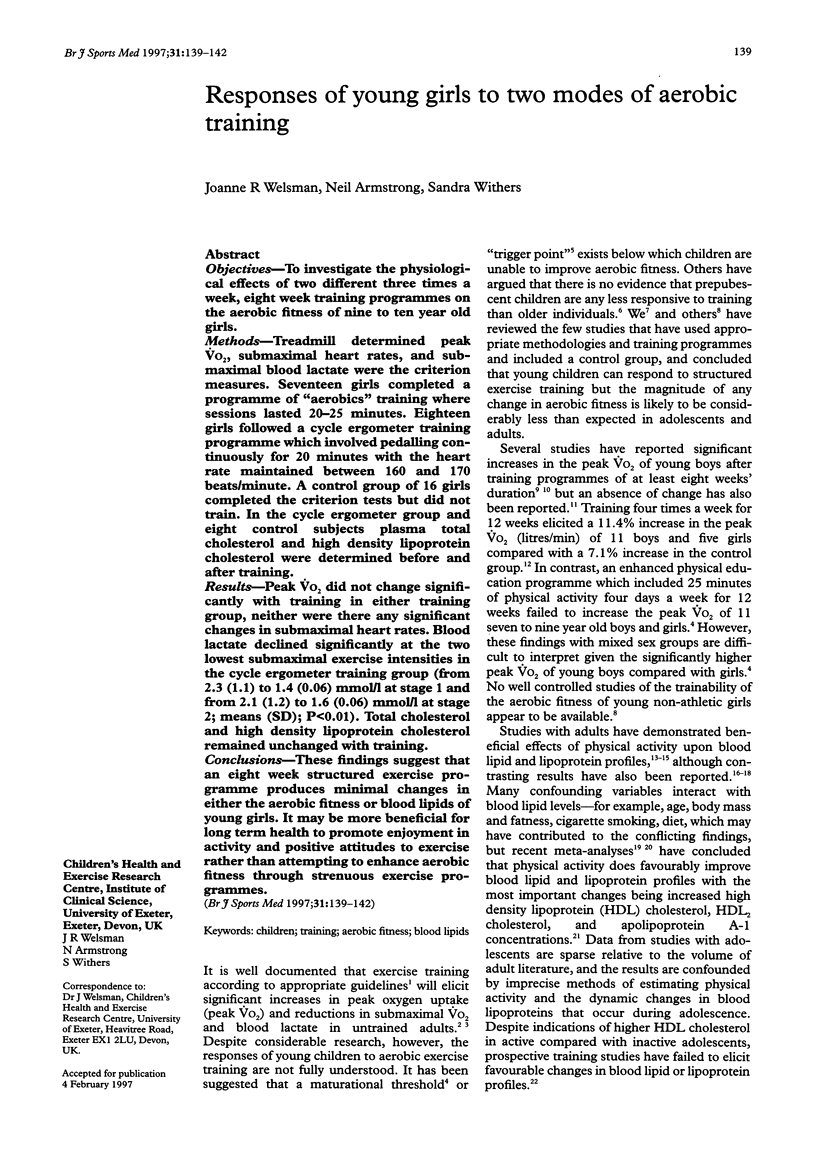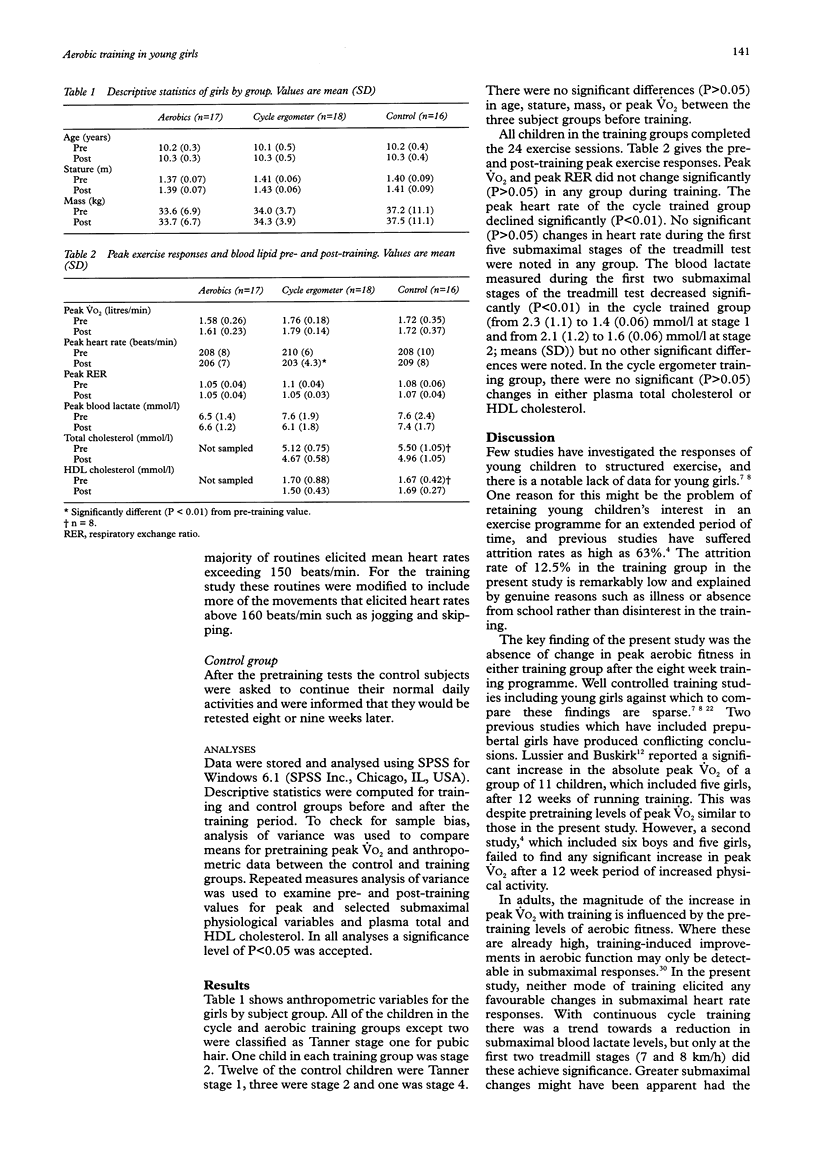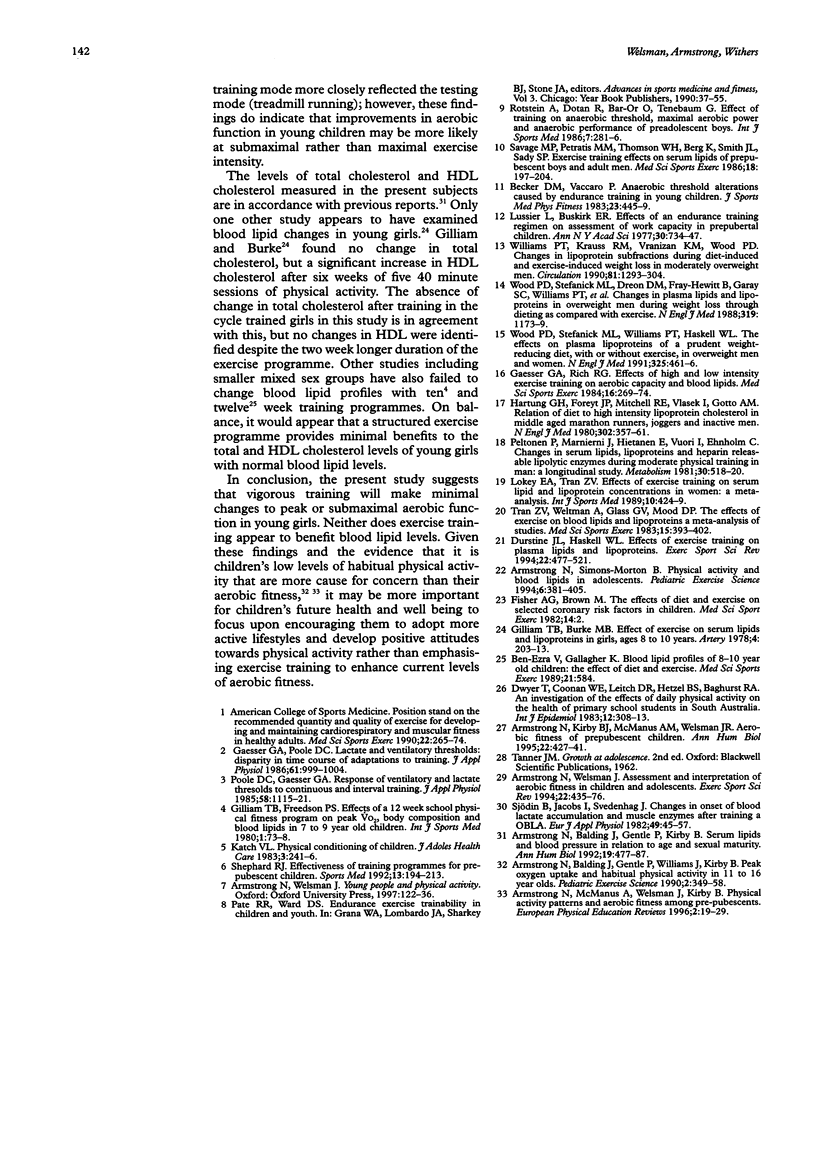Abstract
OBJECTIVES: To investigate the physiological effects of two different three times a week, eight week training programmes on the aerobic fitness of nine to ten year old girls. METHODS: Treadmill determined peak VO2, submaximal heart rates, and submaximal blood lactate were the criterion measures. Seventeen girls completed a programme of "aerobics" training where sessions lasted 20-25 minutes. Eighteen girls followed a cycle ergometer training programme which involved pedalling continuously for 20 minutes with the heart rate maintained between 160 and 170 beats/minute. A control group of 16 girls completed the criterion tests but did not train. In the cycle ergometer group and eight control subjects plasma total cholesterol and high density lipoprotein cholesterol were determined before and after training. RESULTS: Peak VO2 did not change significantly with training in either training group, neither were there any significant changes in submaximal heart rates. Blood lactate declined significantly at the two lowest submaximal exercise intensities in the cycle ergometer training group (from 2.3 (1.1) to 1.4 (0.06) mmol/l at stage 1 and from 2.1 (1.2) to 1.6 (0.06) mmol/l at stage 2; means (SD); P < 0.01). Total cholesterol and high density lipoprotein cholesterol remained unchanged with training. CONCLUSIONS: These findings suggest that an eight week structured exercise programme produces minimal changes in either the aerobic fitness or blood lipids of young girls. It may be more beneficial for long term health to promote enjoyment in activity and positive attitudes to exercise rather than attempting to enhance aerobic fitness through strenuous exercise programmes.
Full text
PDF



Selected References
These references are in PubMed. This may not be the complete list of references from this article.
- Armstrong N., Balding J., Gentle P., Kirby B. Serum lipids and blood pressure in relation to age and sexual maturity. Ann Hum Biol. 1992 Sep-Oct;19(5):477–487. doi: 10.1080/03014469200002312. [DOI] [PubMed] [Google Scholar]
- Armstrong N., Kirby B. J., McManus A. M., Welsman J. R. Aerobic fitness of prepubescent children. Ann Hum Biol. 1995 Sep-Oct;22(5):427–441. doi: 10.1080/03014469500004102. [DOI] [PubMed] [Google Scholar]
- Armstrong N., Welsman J. R. Assessment and interpretation of aerobic fitness in children and adolescents. Exerc Sport Sci Rev. 1994;22:435–476. [PubMed] [Google Scholar]
- Becker D. M., Vaccaro P. Anaerobic threshold alterations caused by endurance training in young children. J Sports Med Phys Fitness. 1983 Dec;23(4):445–449. [PubMed] [Google Scholar]
- Durstine J. L., Haskell W. L. Effects of exercise training on plasma lipids and lipoproteins. Exerc Sport Sci Rev. 1994;22:477–521. [PubMed] [Google Scholar]
- Dwyer T., Coonan W. E., Leitch D. R., Hetzel B. S., Baghurst R. A. An investigation of the effects of daily physical activity on the health of primary school students in South Australia. Int J Epidemiol. 1983 Sep;12(3):308–313. doi: 10.1093/ije/12.3.308. [DOI] [PubMed] [Google Scholar]
- Gaesser G. A., Poole D. C. Lactate and ventilatory thresholds: disparity in time course of adaptations to training. J Appl Physiol (1985) 1986 Sep;61(3):999–1004. doi: 10.1152/jappl.1986.61.3.999. [DOI] [PubMed] [Google Scholar]
- Gaesser G. A., Rich R. G. Effects of high- and low-intensity exercise training on aerobic capacity and blood lipids. Med Sci Sports Exerc. 1984 Jun;16(3):269–274. [PubMed] [Google Scholar]
- Hartung G. H., Foreyt J. P., Mitchell R. E., Vlasek I., Gotto A. M., Jr Relation of diet to high-density-lipoprotein cholesterol in middle-aged marathon runners, joggers, and inactive men. N Engl J Med. 1980 Feb 14;302(7):357–361. doi: 10.1056/NEJM198002143020701. [DOI] [PubMed] [Google Scholar]
- Katch V. L. Physical conditioning of children. J Adolesc Health Care. 1983 Jan;3(4):241–246. doi: 10.1016/s0197-0070(83)80245-9. [DOI] [PubMed] [Google Scholar]
- Lokey E. A., Tran Z. V. Effects of exercise training on serum lipid and lipoprotein concentrations in women: a meta-analysis. Int J Sports Med. 1989 Dec;10(6):424–429. doi: 10.1055/s-2007-1024937. [DOI] [PubMed] [Google Scholar]
- Lussier L., Buskirk E. R. Effects of an endurance training regimen on assessment of work capacity in prepubertal children. Ann N Y Acad Sci. 1977;301:734–747. doi: 10.1111/j.1749-6632.1977.tb38243.x. [DOI] [PubMed] [Google Scholar]
- Peltonen P., Marniemi J., Hietanen E., Vuori I., Ehnholm C. Changes in serum lipids, lipoproteins, and heparin releasable lipolytic enzymes during moderate physical training in man: a longitudinal study. Metabolism. 1981 May;30(5):518–526. doi: 10.1016/0026-0495(81)90190-6. [DOI] [PubMed] [Google Scholar]
- Rotstein A., Dotan R., Bar-Or O., Tenenbaum G. Effect of training on anaerobic threshold, maximal aerobic power and anaerobic performance of preadolescent boys. Int J Sports Med. 1986 Oct;7(5):281–286. doi: 10.1055/s-2008-1025775. [DOI] [PubMed] [Google Scholar]
- Savage M. P., Petratis M. M., Thomson W. H., Berg K., Smith J. L., Sady S. P. Exercise training effects on serum lipids of prepubescent boys and adult men. Med Sci Sports Exerc. 1986 Apr;18(2):197–204. [PubMed] [Google Scholar]
- Shephard R. J. Effectiveness of training programmes for prepubescent children. Sports Med. 1992 Mar;13(3):194–213. doi: 10.2165/00007256-199213030-00004. [DOI] [PubMed] [Google Scholar]
- Sjödin B., Jacobs I., Svedenhag J. Changes in onset of blood lactate accumulation (OBLA) and muscle enzymes after training at OBLA. Eur J Appl Physiol Occup Physiol. 1982;49(1):45–57. doi: 10.1007/BF00428962. [DOI] [PubMed] [Google Scholar]
- Tran Z. V., Weltman A., Glass G. V., Mood D. P. The effects of exercise on blood lipids and lipoproteins: a meta-analysis of studies. Med Sci Sports Exerc. 1983;15(5):393–402. [PubMed] [Google Scholar]
- Williams P. T., Krauss R. M., Vranizan K. M., Wood P. D. Changes in lipoprotein subfractions during diet-induced and exercise-induced weight loss in moderately overweight men. Circulation. 1990 Apr;81(4):1293–1304. doi: 10.1161/01.cir.81.4.1293. [DOI] [PubMed] [Google Scholar]
- Wood P. D., Stefanick M. L., Dreon D. M., Frey-Hewitt B., Garay S. C., Williams P. T., Superko H. R., Fortmann S. P., Albers J. J., Vranizan K. M. Changes in plasma lipids and lipoproteins in overweight men during weight loss through dieting as compared with exercise. N Engl J Med. 1988 Nov 3;319(18):1173–1179. doi: 10.1056/NEJM198811033191801. [DOI] [PubMed] [Google Scholar]
- Wood P. D., Stefanick M. L., Williams P. T., Haskell W. L. The effects on plasma lipoproteins of a prudent weight-reducing diet, with or without exercise, in overweight men and women. N Engl J Med. 1991 Aug 15;325(7):461–466. doi: 10.1056/NEJM199108153250703. [DOI] [PubMed] [Google Scholar]


